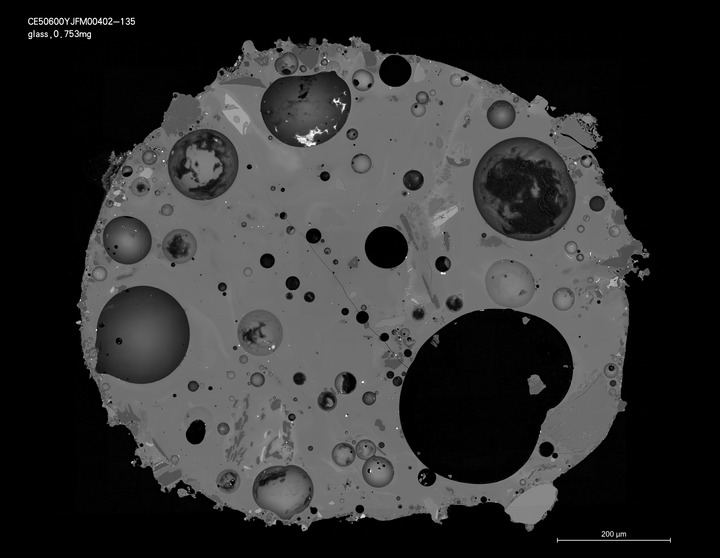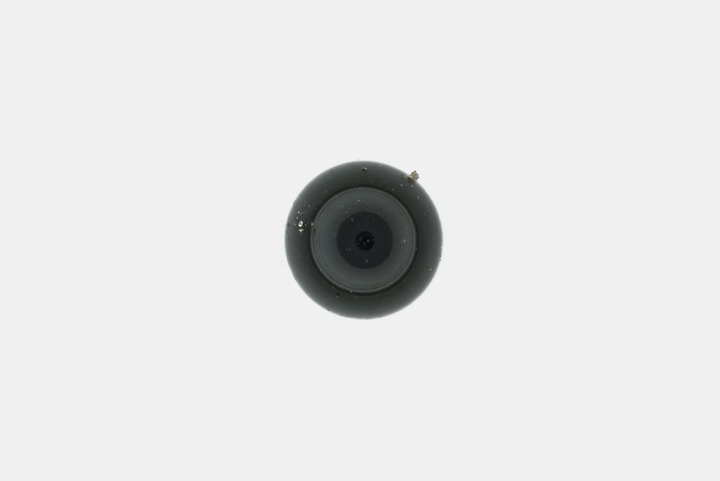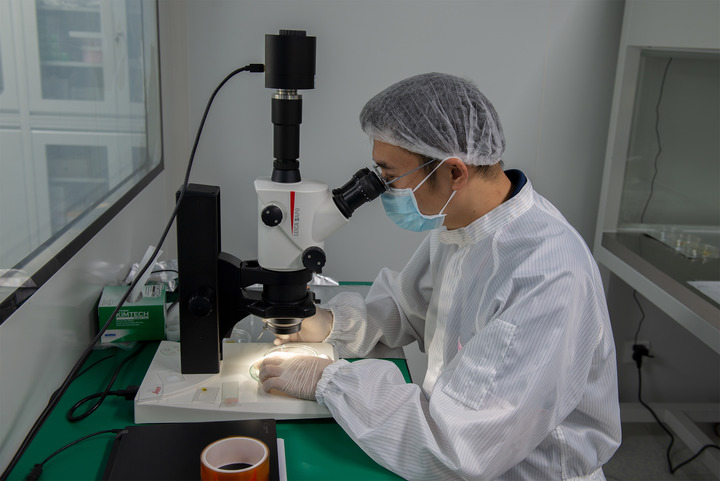Monthly to enjoy the moon: Chinese scientists show the micro -micro beauty of Chang'e 5 Monthly
Author:Xinhuanet Time:2022.09.10
Xinhua News Agency, Beijing, September 10 (Reporter Yu Fei, Yang Chunxue) Chinese scientists and artists cooperate to start a new moon -viewing mode in the Mid -Autumn Festival: through high -tech means, let people appreciate the beautifully hidden beauty in the dust of the moon. Micro world.

This is a orthogonal polarity of a basalt fragments in the Chang'e -5 moon soil taken on July 7. (Pictures of the Institute of Geology and Earth Physics of the Chinese Academy of Sciences)
At the end of 2020, Chang'e 5 completed the first land sampling in China, and brought back 1731 grams of moon soil from the moon. Chinese scientists' research on Chang'e -5 sample refreshed the human awareness of the evolution of the moon.
"The moment our team got a sample of Chang'e 5 last year, the kind of excitement and pride was unforgettable for life." Said Yang Wei, a researcher at the Institute of Geology and Geophysics of the Chinese Academy of Sciences. Among the 1.4 billion Chinese people, he is one of the few people who can contact the moon soil at close range. Not only can he "raise his head and look at the moon", but also bow his head to enjoy the moon.
"The moon soil has almost covered the surface of the moon. It is like a historical book. Every dust in the moon can tell the story that happened on that planet. The device cannot be seen at all. For the vast majority of people, Yueyang is a book of heaven, and he can't understand it clearly. "Yang Wei said.

This is the cross -section of the cross -section of a glass beads in the Chang'e -5 moon soil on April 10th. (Pictures of the Institute of Geology and Earth Physics of the Chinese Academy of Sciences)
"When we got the moon sample last year, we were anxious to get new discoveries. I saw a lot of phenomena that I never saw, but it was too late to record it in the best way. We apply for moon samples again at the beginning of this year. Recording the Moon soil I saw in the most beautiful way. I feel that I have a responsibility to share this beautiful micro -world and the joy of understanding Tianshu with the public. "Yang Wei said.
To this end, Yang Wei united experts from the Institute of Computing Technology of the Chinese Academy of Sciences and artists from the Central Academy of Fine Arts. beauty of.
The technicians used a 355 micrometer -diameter sieve to sieve large 146 particles from the obtained monthly soil samples to make each particle number; micro -photography experts move heavy equipment to scientists' laboratories; artists guidance How to light up when taking pictures and how to make coloring photos; scientists ponder how to fix the tiny monthly dust to create a suitable shooting environment.
They made HD CT for Yueyang particles and classified them according to the internal structure; they also used depth of landscape synthetic microscopic photography technology to take high -definition photos for each particle. In order to achieve the effect of the exhibition, each particle must take hundreds of local photos under the electron microscope and then fight. It took summer from winter.

On February 20th, a micro -photo with glass beads with a diameter of only 0.5 mm in the Chang'e 5 Monthly Month of Chang'e 5. The surface of the glass beads reflects the image of the camera, like a round eye. (Pictures of the Institute of Geology and Earth Physics of the Chinese Academy of Sciences)
In the micro -world of the moon, Yang Wei saw a round glass bead with a diameter of only 0.5 mm. Because its reflection was too strong and very difficult to take, the surface of the glass beads reflected the image of the camera. A round eyes with pupils looked at the world in surprise.
Those dust from the moon is too small, and accidentally fly away in the air of the earth. Yang Wei thought about many ways to fix them. At first, he wanted to stick to the tape, and he was afraid that the stickiness was too strong and could not be removed. Finally, he was adsorbed on the plate with static electricity.
Yang Wei said that the unique phenomenon of many months he had only been read in the literature before and had never seen him with his own eyes. For example, unlike the earth soil, a large part of the moon is glass. Due to the atmosphere on the earth, the small meteorite will be able to fall into the ground in the atmosphere. However, in the moon without atmosphere, the small meteorites hit the moon at a high speed, and under the action of high temperature, the part of the micron scale melts, and then sticks to various strange bonding with other small moon soil particles. In his shooting moon dust, there is a shape that looks like a pet puppy.

A micro -photo of a adhesive in Chang'e 5 on February 19th, the shape resembles a pet puppy. (Pictures of the Institute of Geology and Earth Physics of the Chinese Academy of Sciences)
In a kind of orthogonal polarizer, people can see the colorful patterns of minerals in the moon granules, including flowers, butterflies, stars ...
"These colors are caused by the interference of light. This is a common method for identifying minerals. Although it has been gradually replaced by electron microscope technology, it shows the beautiful side of the moon." Yang Wei said.
On the basis of HD CT and micro -photography, computer experts have produced three -dimensional reconstruction of monthly soil particles, and simulated the strength and angle of the Chang'e -5 landing area at noon. It looks like.

On September 2nd, Yang Wei, a researcher at the Institute of Geology and Geophysics of the Chinese Academy of Sciences, observed the moon soil through a microscope. Xinhua News Agency reporter Yu Fei Photo
Gao Lin, an associate researcher at the Institute of Computing Technology of the Chinese Academy of Sciences, said that Yueyang analysis and three -dimensional reconstruction are an unknown area. It is exciting to participate in exploring this unknown area. "We artificially display the reconstructed three -dimensional models of the monthly soil, combined with VR/AR technology, so that ordinary people can interact with the moon granules through mobile phones or computers to experience the beauty of the moon soil."
These achievements met the world at the "Reading -Moon Royal Research Achievement theme Art Exhibition" unveiled on the 10th. Wang Yi, a member of the exhibition planning and creating team, and the teacher of the Central Academy of Fine Arts, said that in this exhibition, scientists, artists, and engineers based on their own studies, combined and welcomed together. New experience.
"This presentation has a visual" sophisticated, which causes the vast "feeling, and the lack of hair thickness of the monthly soil particles contains such a rich world. The infinite possibility of integration. This month's presentation attempts to borrow the cutting -edge scientific content to use art to make the public reach the tentacle, and experience the cultivation of the aesthetic perception of the public while experiencing the mystery of the universe. "Wang Yi said.
Yang Wei said: "When science was born, almost all scientists were also artists. Today, hundreds of years later, the society is highly divided into labor, science and art are divided. Fusion, scientific exploration inspiration of artistic creation, art imagination leads scientific research. "
- END -
The expert group of the autonomous region came to Changji Prefecture to "consult the pulse" for the enterprise
Changji Daily (all -media reporter Wu Qian Correspondent Ma Yu) Recently, the Autonomous Region Market Supervision and Administration Bureau specially invited the Beijing Navigation Standard Times Ins
In response to rainfall today, more than 600,000 disposable raincoats are prepared by the Beijing -Hong Kong Metro

In order to do a good job of responding to rainfall weather from June 26th to 27th...